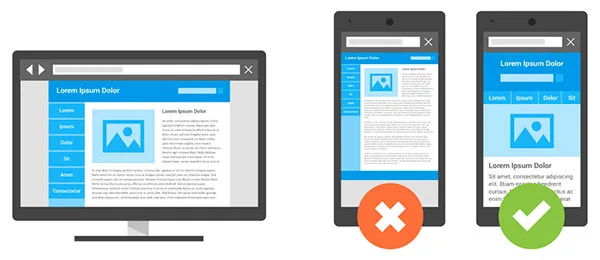Why Your Online Shop Doesn’t Sell: 22 Possible Reasons with Fixes
No sales again and you are getting desperate? This article will tell you all about the possible reasons why this might be happening and how to fix the problem so you can start making money with your online shop.
1. Your website is bad
If your website is hard to navigate or unattractive, buyers will move on to better options in a blink. The speed of loading is also a major factor here. And with a website like that, you won’t be able to get a high Google ranking.
Fixes:
- Have your website audited by a pro, who will check its UX, usability, SEO, and other important features.
- Fix all visible mistakes.
- Upgrade website design and the Menu.
- Check the loading speed as your platform might be unable to deal with the traffic.
- Review all your content.
PHOTO (That’s what horrid website design looks like)

2. Your prices are too high
This means that your prices are too high for your niche and consumers cannot understand why they should overpay if they can buy the same thing cheaper from your competitors.
Fixes:
- Provide reason for the higher prices (for example, you offer top-quality service, free shipping, extended warranty, etc.)
- Improve your branding and marketing to present your business as a luxury store.
- If you can’t prove you offer better value, reduce your prices to the market average.

3. Your service is subpar
For example, your managers are rude and the customer support service doesn’t offer much support.
Fixes:
- Provide your managers with better training.
- Remove toxic employees.
- Provide employee motivation.
- Change the delivery services and transportation companies you work with.
- Install CRM to manage your databases more efficiently.
- Hire more employees if your staff can’t handle the traffic.
- Explain product warranty terms as well as return and replacement policies on the website.
PHOTO (Benefits of using CRM)
4. Your product is bad
Your products break down, fall apart, or malfunction often.
Fixes:
- Start working with different brands.
- Change your suppliers.
- Set up a quality control system.
- Review supplementary service providers, like the contractors that install your equipment as they might be the ones to mess up.
5. Your niche is too competitive
If your niche is full of big retail chains that use guerilla marketing and more effective business models or play dirty and dumping, you are in trouble.
Fixes:
- Try to get rid of competition by either developing a unique selling proposition or choosing a different target audience.
- Change the brands of products you offer to evade competition.
- Cut the prices if possible.
- Optimize your business processes to cut costs.
- As the last resort, change your niche.
PHOTO (Rules of overcoming competitors)
6. Your targeting is off
For example, you are trying to sell middle-market products to upper-class customers or cutting-edge tech to retirees.
Fixes:
- Identify the right target audience.
- Find out their needs and demands.
- Determine the right channels and methods of communication.
- Choose an appropriate product.

7. You aren’t using social media
By not using social media you are missing out on over half of the most effective marketing channels and only generate organic traffic through search engines and paid ads.
Fixes:
- Develop and launch an SMM campaign.
- Create business accounts and purchase targeted ads at top social networks.
- Provide feedback to users.
- Regularly post shareable content (surveys, infographics, etc.)
- Organize contests.
- Publish viral posts.
- Upload videos.

8. You have many negative reviews
The majority of consumers look up customer reviews online, so if they are negative, you won’t get much business.
Fixes:
- Deal with negative reviews on your website and social media.
- Ask buyers to post testimonials not only on your website but also on popular consumer forums like GoogleReviews or Yandex.Market.
- Take steps to fix the problems noted in negative reviews. For example, improve your customer service or change a delivery service if people complain about shipping.
- Never ignore a negative review! Instead, contact the customer immediately and try to fix the problem. You must never delete negative comments or prevent commenting on your social media accounts.
PHOTO (Frequency of consumers studying reviews for the products/services they intend to buy)
9. You aren’t using online marketing
You might choose to go the “traditional” way and run your ads on the local radio and media outlets. However, today it’s not enough.
Fixes:
- Launch a massive online marketing campaign. You can learn how to do this studying a variety of specialized resources, like this blog.
- Visit conferences, seminars, and workshops to learn more about online marketing.
- Hire a digital marketing agency.
- Subscribe to this blog.
- Apply all your new knowledge in practice.

10. Your contextual advertising is off the mark
Contextual advertising will work only if it targets the right audience at the right time. The main factors you’ll need to consider during targeting are age, location, keywords, etc.
Fixes:
- Check your contextual advertisement campaign settings.
- Rework your keywords and negative keywords lists.
- Review your advertising channels.
- Revise and change the content of your ads.
- Improve your landing pages.
- If none of the above helped, hire a different contextual advertisement professional.
PHOTO (Survey on the most effective marketing types)
11. Your website isn’t optimized for mobile
Even Google has the “mobile-first” policy in its ranking and more people browse the Web and shop online from their smartphones and tablets, so there will be no great sales without a great mobile optimization.
Fixes:
- Hire a web development professional to optimize your website.
- Develop a dedicated mobile app.
- Move your online shop to a different platform. Top platforms, like InSales, are mobile-optimized by default.

12. You are using bad SMM practices
Things like buying subscribers or buying spamming bots are very bad SMM practices. Not posting any content of value also falls into that category.
Fixes:
- Identify your target audience.
- Research the types of content they will be interested in.
- Develop a social media marketing strategy.
- Develop a content publishing plan and schedule.
- Post new content regularly and frequently.
- Have a person responsible for managing your social media accounts (posting, responding to comments and messages, moderating, etc.)
- If possible, hire an SMM professional.
PHOTO (Steps of SMM strategy development)
13. You have too many widgets on your website
If a visitor coming to your website is met with a torrent of pop-up windows and ads, accompanied with some videos or music that’s hard to disable, they will be extremely annoyed with this widget mania and leave the site immediately.
Fixes:
- Rework your widgets, they should be used only when they are truly needed.
- Make sure all widgets that you do use can be disabled fast.
- Never install widgets that will all launch at the same time.
- Widgets that you do use must be triggered by the visitor’s on-site actions.
14. You don’t have the customers’ trust
If your website doesn’t rate high on the trustworthiness scale, the information you provided prospective buyers with isn’t sufficient.
Fixes:
- Post all important business details on your website. They include: your address, phone numbers, license and registration details, email, links to social media groups. You can also add Google Maps coordinates and a call center number.
- Publish and share testimonials from verified buyers.
- Post pictures of your team and office.
- Create videos.
- Organize real-life events.

15. You don’t know how to work with corporate clients
Corporate clients require special handling, but they can boost your revenue greatly. A B2B business that doesn’t know how to do B2B selling is doomed to fail.
Fixes:
- Provide information relevant to a business partnership on your website (payment, shipping, and other important details your prospective partners will need to know).
- Hire a specialized professional with experience in B2B sales.
- Develop a loyalty program for corporate clients (include discounts, credit, bonuses for big purchases, etc.)
- Use newsletters and cold emails as they are effective for this type of clients.
- Organize presentations.
- Be ready to present proposals and participate in tenders.
PHOTO(B2B vs. B2C sales)
16. Your prices are too low
Surprisingly many consumers are suspicious of cheap products and “too good to be true” offers.
Fixes:
- Rethink your pricing as your prices must not be too different from the average market price without a concrete reason for the discrepancy.
- If you work in a budget niche, be sure to state this fact clearly and explain that yes, your products are cheap because they are made at some nameless factory in China, but you guarantee that the quality is good.
- Provide reasons for your lower-than-average prices, for example, you might have a more effective business model that reduces your overhead costs.
17. You don’t have the USP
USP stands for Unique Selling Proposition, which is your main advantage over your competitors. This is the thing that makes you stand out and without it, your business has little chance of success. Bear in mind that affordability and quality aren’t USPs, they are the norm for an online shop.
Fixes:
- Study your competitors and identify their strengths and weaknesses.
- Decide on the benefits you can provide.
- Research the problems and needs of your target audience.
- Determine which of your benefits can help solve the aforementioned problems.
- Develop a USP that will address some major issue thus invoking a strong emotional response from the buyer.
PHOTO(USP development stages)
18. Your website isn’t designed to sell
What’s the first thing a visitor sees when they open your website? Can they identify it as an online store? If not, you are doing it wrong.
Fixes:
- Your home page is the “showroom” of your store, so make it look like it by posting pictures of your top-selling products and hottest deals.
- Add CTA buttons and other elements that will help motivate visitors to buy.
- Study the Home Page Design Rules.

19. Your positioning is off
The positioning of your shop is a combination of choosing the niche and target audience as well as developing a USP. If these elements aren’t in harmony, your positioning is wrong and your business is inefficient.
Fixes:
- Identify the right niche.
- Identify the target audience and choose a product that will be of interest to it.
- Set yourself apart from the competition.
- Highlight your benefits.
- Develop an effective message for your audience.
- Determine the right channels and methods of communication.
20. You aren’t using sales funnels
Sales funnels are a way to boost your sales by increasing the time prospects spend on the website and by reigniting interest in those who have already purchased something from you, for example by means like abandoned carts’ reminders.
Fixes:
- Develop sales funnels that will fork for your specific shop.
- Automate your emails.
- Adopt services that increase conversion.
- Develop and launch a trigger system that will respond to prospects’ actions on the website.
- Order sales funnels designed by professionals.
PHOTO(Classic sales funnel)
21. Customers must register to buy
The longer the checkout process takes, the fewer sales you make.
Fixes:
- Simplify your registration process or forego it completely.
- Forewarn the visitors that they cannot make a purchase without registering.
PHOTO(Simple registration forms)
22. You don’t guarantee safe payments
It’s imperative to ensure that your customers know where exactly their money goes and that the transaction is secure.
Fixes:
- Only use trusted and reputed payment systems.
- Use SSL encryption.
- Provide payments details information on the website.
- Make the payment process as transparent as possible.
In Conclusion
Take a look at your online shop right now and check it for any signs of mistakes listed above. If even one of them is there, you need to fix it right away.

The quality of your website is a major factor in determining your online store’s success. And usability, in turn, is […]

Today we will talk about how to design an online store for success. It’s not only about the aesthetic appeal, […]

E-commerce businesses have to use a variety of methods in order to win customers in the extremely competitive markets of […]

The number of customers you have determines the success of your business, socially in a highly-competitive industry like e-commerce. A […]

Did you launch your online shop years ago and never got to upgrading its design? Are you using one of […]
